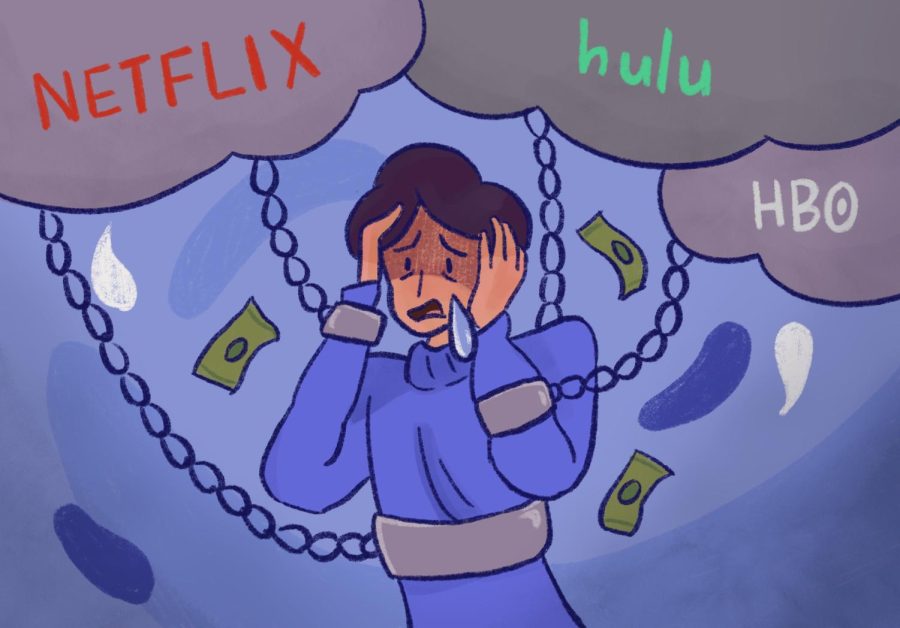Trauma Voyeurism: An Unethical Means of Gaining ‘Clicks’ in the Modern Age
Media platforms such as Netflix and Hulu often weaponize and manipulate the trauma of real people for financial gain, failing to provide accurate consideration for these real people’s lives. “I feel like it is impossible to only want to inform. You need people who finance these shows and documentaries, and they want to see certain things,” science teacher Michael Tang said. “I don’t think we can ever achieve objectivity or completely good intentions. It’s so tied to money; it’s so tied to fame.”
Viral content is a cornerstone of modern media — shocking, dramatic and scandalous news gains millions of views, regardless of whether it contains the entire truth. Many projects present allegedly true stories to entice viewers to feel more invested in the material.
However, not all of these “based on a true story” projects directly revolve around the creator. Works deemed true crime often follow real events in other people’s lives, prompting controversies as to the ethicality of these depictions.
When depicting a real event on screen, how much creative freedom do the makers have without straying too far from the truth? Is it respectful to fictitiously portray a real person without their consent? Is the privacy of the subjects at risk by making their struggles public to a wider audience? Most of all — is it ethical to recreate a person’s most traumatic memories for entertainment value in the true crime genre?
Regardless of potential entertainment value, these types of dark content should not continue to flourish in mainstream media due to their disregard for the possibility of a re-lived trauma experience and their constant weaponization of real people’s emotions. It is important that viewers should remain skeptical of the content, out of respect to the victim(s) and their families.
In recent years, the pattern of trauma voyeurism and exploitation of the “vulnerability of a victim for the purpose of securing viewership” has only increased, according to NSRVC. Cinematic projects such as “Blonde” and “Monster: The Jeffrey Dahmer Story” serve as a means to perpetuate the “trend” of trauma voyeurism.
Films that use trauma voyeurism fail to value ethics and can be designed for financial motives, commercializing real emotions and relying on viral marketing to get messages across.
Films such as Jordan Peele’s “Nope” attempt to address the underlying issues of using someone’s life story solely to generate a profit — but this genre of exploitative media continues to prevail.
In its debut week, “Blonde,” a film depicting a fictionalized account of key events in Marilyn Monroe’s life, was watched for 37,340,000 hours, according to Netflix’s Global Top Ten Chart. This comes despite the film featuring multiple graphic scenes of sexual assault and rape while neglecting to expand on Monroe’s lasting legacy.
“It is very clear, the media weaponizes trauma,” science teacher Michael Tang said. “And ‘Nope’ is about people themselves; they actually use their trauma to get attention.”
Making someone’s trauma public can also create lasting impacts on victims’ families by publicly branding them witnesses to a traumatic event. Victims, as well as loved ones, often find that their identities are entirely encompassed by tragedy, as every part of their lives becomes defined by a singular event until it is impossible to move on.
The depiction of one’s personal trauma on screen may cause victims to feel their pain resurfaced, forcing a harsh burden onto their family members, according to the U.S Department of Veterans Affairs. Publicizing such private and sensitive information can remain triggering for the subjects.
Not only this, but the creative freedom of producers when making such content can also romanticize the offenders, undermining the trauma of victims. Social media platforms, such as TikTok and Instagram, can fuel the expansion of such controversial beliefs. The widespread use of social media platforms among young generations can especially fuel the expansion of such controversial beliefs, with viral marketing being used to create talking points and spark reader interest.
A number of viewers of true crime series such as “Extremely Wicked, Shockingly Evil and Vile” and “Tiger King” expressed compassion for the serial killers, going as far as making romantic edits of these men and their victims.
“I think we’re going further and further down that path of true crime as entertainment,” Dr. Xanthe Mallett, a forensic criminologist who specializes in true-crime productions, said in an interview with the Sydney Morning Herald. “It shouldn’t just be a voyeuristic step-through the most traumatic and awful circumstances in a group of people’s lives.”
When exposed to such media, individuals should remain rooted in only the truth of the story and always respect the victims by being conscious of the deceptive elements that may be present in the content. One should respect victims by refraining from reposting or spreading content created under voyeuristic circumstances.
Your donation will support the student journalists of Portola High School. Your contribution will allow us to purchase equipment and cover our annual website hosting costs.

Hannah Ko is the Opinion Editor for her third and final year on the Portola Pilot. This year, she is excited to create meaningful opinion stories especially...

Tara Vatandoust is an Editor-in-Chief for her third, and sadly, final year on the Portola Pilot. This year, she is looking forward to (finally!) being...

Mia Jong is the Co-Managing Editor for her third and final year on the Portola Pilot. She loves to create, whether it be with a paintbrush and canvas or...





